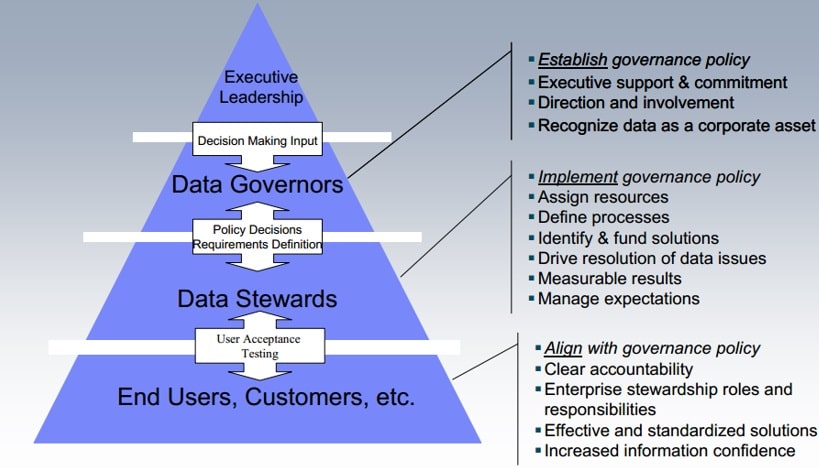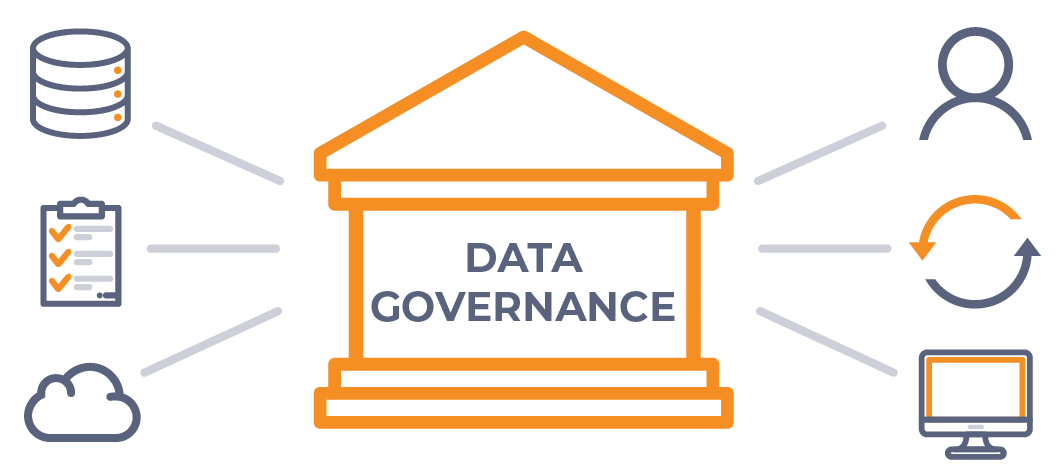Data governance is not the same as IT governance. IT governance makes decisions about IT investments, the IT application portfolio, and the IT project portfolio. IT governance aligns IT strategies and investments with enterprise goals and strategies. Data governance focuses exclusively on the management of data assets.
Data Governance is the core function of the Data Management Framework. This essentially is high level executive data stewardship.
Shared decision making is the hall mark of Data Governance (i.e. partnership between business and I.T)
Data Stewardship
A data steward is a business leader and/or recognized subject matter expert designated as accountable for business responsibilities ensuring effective control and use of data assets. Data stewardship responsibilities exist in all data management functions, not just in data governance.
The best data stewards are found, not made.
Many of the data stewardship activities are performed by business professionals even before a formal data stewardship program is implemented. Appointing the people already interested and involved-> recognition and confirmation of the work they are already performing, but also formalizes their accountability.
Also check: Introduction to Data Resource Management
Why Data Governance?
Data Governance is “the government of data” within the enterprise. Using the same analogy of a representative government there are several common principles.
- DG includes responsibility for
- Legislative Functions (policies/standards)
- Judicial Functions (issue management)
- Executive Functions (administration/compliance)
- DG operates at both enterprise and local levels.
- Duties are separated between Data Stewardship (Legislative/Judicial) and Data Management (Executive) to provide checks and balances.
What is the benefit of Data Governance ?
DG can be viewed as a quality control discipline for using, improving and protecting organizational information. DG enhances collaboration and structured policy making – resulting in better quality, availability, integrity, and protection of data.
It directly impacts four quite critical factors :
- Increasing revenue
- Lowering costs
- Reducing risks
- Increasing data confidence.
One governance structure :

How to get started
- Define desired outcomes from Data Governance
- Be clear about the problems you are solving
- Define a realistic organizational structure for your environment
- Focus on a DG pilot program that can deliver outcomes with business benefits
- Take advantage of best practices and models from organizations like the Data Governance Council
- Set realistic goals.
DG focus areas
DG commonly involves these six areas:
- Policy, standards and strategy
- Data Quality
- Architecture and integration (Support established organizational architecture standards whilst considering integration challenges)
- Privacy, compliance
- Business Intelligence/ Data warehousing
- Management support
Goals of Data Governance:
Below are some goals of data governance:
- Better decision making
- Contribute to data goals and strategy
- Reduce operational inefficiency
- Describe roles of stakeholders
- Train management and staff to adopt common approaches to issues
- Build standard, repeatable processes
- Coordinate efforts across different groups/divisions
- Provide accountability and transparency of processes
- Create and review policies and standards
- Establish decision rights and access management
- Contribute to business rules involving data
- Ensure consistent data definitions (single version of truth)
- Clarify the value of data assets
- Provide oversight for data related projects
Guiding Principles of Data Governance:
- DM is a shared responsibility between business data stewards and DM professionals
- Data stewards have responsibilities in all 10 DM functions
- Every DG program is unique, taking into account the unique characteristics of the organisation and its culture
- It is best to appoint people who are already interested and involved as data stewards
- Shared decision making is the hallmark of DG
- DG can be viewed using a “representative government” analogy
- DG occurs at all organisational levels
- Every enterprise should have a data strategy, driven by the enterprise business strategy, and used to guide all DM activities.
DG Activities
Will typically include responsibility for the development and maintenance of:
- Data Strategies
- Data Policies
- Data Architecture
- Data Standards and Procedures
- Regulatory Compliance
- Issue Management
- Data Management Projects
- Data Management Services
- Data Asset Valuation
- Communication and Promotion
I hope you guys find this article helpful. See you soon in next article.


